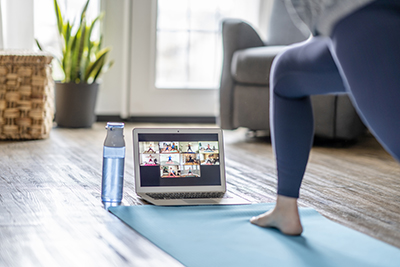14 May 2024
AUTHOR: Will Venn
When 100-year-old Colin Thorne completed a 5km parkrun in New Zealand this year, he thanked the thousands across the parkrun community who had cheered him on, acknowledging their support as motivation for his achievement.
Whether it’s group support, friendly competition or even the simulated fear of being attacked by zombies, whatever gets people to move more is to be encouraged; a helpful buffer to modern sedentary living that has seen adult obesity rates double since 1990, with adolescent obesity quadrupling.
Over the same period, computer games have soared in popularity and have been criticised by some for shifting people off sporting fields and onto sofas. Given this, there’s some irony in that fact that elements of computer game play are now being adopted and adapted to encourage exercise.
Being able to tap into the psychology of motivation and ‘game’ it through apps has triggered huge growth in the fitness app industry, and today about a quarter of Australians aged 20-40 report using fitness trackers.
Step counts, heart rates and sleep cycles are among the more popular health patterns being observed through smartphones, smartwatches and fitness bands.
Yet, gamification; using social and reward elements to spur motivation, is increasingly commonplace in many people’s exercise routines, whether they like to run or are in fact, running for ‘likes’.
Understanding which elements are most effective is the outcome of work undertaken by research centres including the Alliance for Research in Exercise, Nutrition and Activity (ARENA) at UniSA.
Almost a decade ago, ARENA created a smartphone app, Activeteam, which enabled users, who had linked to the app via their Facebook account, to form teams utilising friendship networks, to do physical activities together.

ARENA director Professor Carol Maher says the idea was to generate friendly rivalry within teams or to compete with other teams, with participants posting messages on a message board in the app.
“We did two versions of this, a simple early version whose results were promising, and consequently we received NHMRC funding for further study [from 2015-2019], but because technology had moved on so quickly, we almost started again with new software,” Prof Maher says.
The joy of competing with friends, virtually

“In the second version, we put more focus on people competing within their friendship group, rather than the friendship group competing with random groups of strangers. This was because the early version showed that people were more interested in competing with their friends.
“We created a range of challenges – using gamification to keep the program new and fresh. Participants could send mini challenges to friends and our software had gifts that participants could unlock by doing more exercise, which they could then send to a friend – encouraging reciprocal interaction.
“Our program was to use gamification in a really positive, supportive way. The idea was to make the program fun and socially engaging.”
The ARENA team found that the gamified app achieved higher app usage and goal adherence. Getting users to engage more was a crucial factor in increasing their physical activity.
That study showed that some gamification features were more popular than others – in particular, leaderboard and status.
So how exactly does gamification work?
“A lot of gamification features map really well on to proven behaviour change techniques,” Prof Maher says.

“So things like being able to monitor your change in performance over time, getting regular feedback on how well you’ve performed, how you compare with other people; getting rewarded for a streak; doing the same behaviour a certain number of days in a row. It completely makes sense that this engages people more, encouraging consistency.
“Gamification can also be operationalised in so many different ways; there is the leaderboard, which is about social comparison, the points system, which encourages people to come back to the software, unlockable features, badges or rewards that people can collect for completing different challenges in a program.
“When it comes to a health habit, there’s a general belief that people often use extrinsic motivators when they are forming a new habit – so they might need to reward themselves for doing something or link it to something else they are doing to help them remember to do it.”

ARENA research fellow Dr Ben Singh says that motivational orientation towards physical activity is so strongly linked to fitness apps, that operational features such as those described by Prof Maher, can change the way people perceive exercise.
“These features make workouts more enjoyable and transform exercise from a chore into an engaging challenge,” Dr Singh says.
“Community building and personalised goals also promote commitment and support.
“To be effective, gamified fitness apps must balance game elements with usability, keeping the focus on fitness goals. By providing varied challenges and achievable rewards, these apps make exercise addictive and exciting.
“Carefully implemented gamified features, boost engagement, retention and adherence to fitness goals by leveraging users’ intrinsic motivation to accomplish and progress.”
The advent of wearable technology is also changing the playing field, both in terms of the demographic using fitness apps and the wealth of health data that can be gleaned from them.
“The landscape of the market is fast changing. For years, Fitbit and Garmin were the market leaders. But Australians now favour Apple watches (used by 50% of people owning a wearable tracker) over Fitbit (27%) and Samsung watches (19%) over Garmin (12%),” Dr Singh wrote in The Conversation.
“So far, fitness trackers have mostly been taken up by younger people: about one in four Australians aged 20–40 report using one, compared to just one in 10 people aged 60 or older.
“However, manufacturers are on a mission to change this, with the addition of features that allow users to monitor not just their fitness activity, but several other aspects of their health.
“For instance, recent wearable models from all the leading manufacturers claim to measure a host of medical metrics, such as blood pressure, body fat levels, the amount of oxygen in your blood, your heart activity, and even identify when you’ve taken a fall (with a feature that lets you call for help).
“Wearables enhance gamification by providing real-time data to personalise challenges, rewards and experiences in apps. By leveraging wearable data, developers can tailor gamified elements to user preferences and behaviours, increasing participation and exercise adherence.”
Looking to the future, with the introduction of wearable devices that facilitate augmented and virtual reality, such as Apple Vision Pro, the line between gamified fitness apps and video games is set to become even blurrier.
How you perceive your environment can influence how you exercise within it.
The difference between game design and gamification

Game and Narrative Designer Dr Susannah Emery, who lectures in Game Design and Digital Media at UniSA, says games and gamified applications are converging.
“More and more game elements can be seen in gamification these days,” Dr Emery says.
“The main difference between these is that in game design, the primary focus lies on interactivity, so the design is created with the interactivity in mind, whereas in gamification, the approach often involves coming up with a goal, such as exercising, and then subsequently incorporating game elements.
“During COVID, we saw a huge increase in people playing games, either returning to this after being players in the past or discovering it for the first time.
“Apps such as Zombies, Run! and Pokémon Go! specifically addressed the needs of individuals in isolation by modifying crucial aspects of their game design to align with lockdown requirements, which allowed users to play and stay active while adhering to isolation measures.”
Zombies, Run! is both a mobile fitness app and an immersive role-playing game in which a player is required to walk or run, moving to complete missions and to escape from chasing hordes of zombies, while time, pace and distance are recorded.
In March 2020, The Home Front mode was introduced, enabling users to complete tasks through stationary home exercises, capitalising on global lockdowns as populations self-isolated at the start of the COVID pandemic.
The ability to pivot to real world events, responding to user requirements to vary their exercise routine, while employing story-based narratives akin to popular shows such as HBO’s The Walking Dead, gives such fitness apps a cultural cache that widens their appeal.
A qualitative study of Zombies, Run! by researchers at University College London found that the app may engage people with exercise by modifying their perception of physical activity through a storyline or narrative, dissociating the players from the effort of exertion.
“Technology such as AR/VR has a huge advantage in encouraging players to engage with physical activity through its ability to alter the player’s perception, allowing them to be distracted from negative aspects of their world and encouraging them to do things like exercise,” Dr Emery says.
“Games are really powerful in this space and VR games have even been used in hospitals to help children who were being treated for burns.
“One study placed children inside a VR game called Virtual River Cruise where they activated statues that blew snow, leading to the snow piling up on the player’s boat, with a digital thermometer showing the temperature on the boat was becoming colder – distracting the player from the hot feelings associated with the treatment of their burns.”
When reality and gamification converge
With perception being key to alleviating pain, or at least reducing the physical discomfort of exertion, the ability to manipulate or gamify that perception would appear more necessary in today’s world, where keeping fit is more the process of self-discipline and dedicated effort rather than a side effect of manual driven tasks and labour.
Centenarian and parkrun enthusiast Colin Thorne says that as technology progresses, “we need to move with the times to keep up”.
“I was once a dairy farmer, milking cows mornings and nights and in those days, you ran or walked about the farm and that was enough to keep fit. It is different today,” Colin says.
“Parkrun motivates me to keep going and the support of the parkrun family is amazing – perhaps others seeing this ‘old fellow’ doing it, is encouraging others to give it a go. It is reciprocal.
100-year-old Colin Thorne completed a 5km parkrun in New Zealand earlier this year. He thanked the parkrun community who had cheered him on, acknowledging their support as motivation for his achievement.
“Competition is also motivating, seeing what others of their age or comparable fitness are doing and achieving – even if it’s online, would definitely be great for setting personal goals.
“There’s nothing like encouragement and online competition to try to do better and not to give up.
“We all have our bad days when we don’t feel like doing it, but never give up. If you see your online buddy out doing it, then that may be just enough to motivate you to get out and do it too.”
You can republish this article for free, online or in print, under a Creative Commons licence, provided you follow our guidelines.


